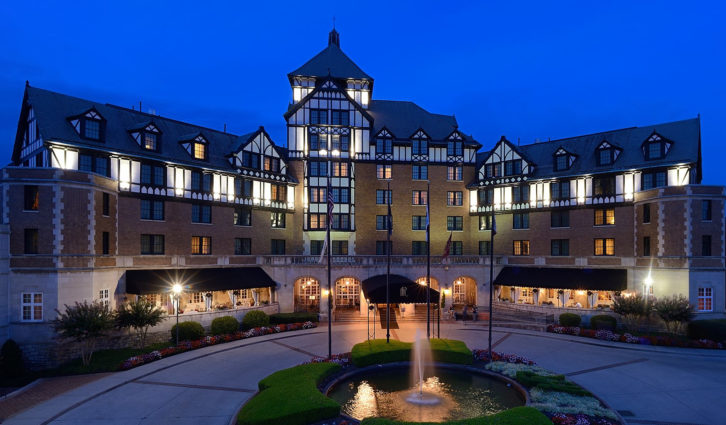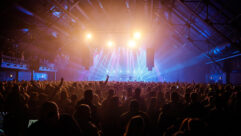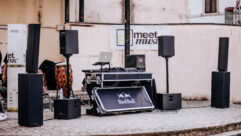
SVC Podcast – Show Notes – Show 126-1:
In this edition of the SVC Podcast, SVC Contributing Editor Bennett Liles talks with project manager Jim Hogan of IES Communications in Roanoke, Virginia about his firm’s replacement of an outdated audio system in the Hotel Roanoke & Convention Center. Jim outlines the installation of Bose RoomMatch Progressive Directivity Array loudspeakers, Bose PowerMatch PM8500N Dante-enabled amps and a Shure wireless microphone system.
Links of interest:
- IES Communications of Roanoke, Virginia
- Bose Modular Array loudspeakers used in the main PA system
- Bose Match PM8500N Dante-enabled amplifiers
- Symetrix SymNet Radius AEC DSP
Photo Credit: Hilton Hotels
Download Podcast Here:
https://s3.amazonaws.com/nb-svc/public/public/126-1_IES_Comm_Roanoke_Hog…
From Sound & Video Contractor Magazine, this is the SVC Podcast with Jim Hogan of IES Communications. Show notes for the podcast are available on the web site of Sound & Video Contractor Magazine at svconline.com.
When the historic Hotel Roanoke and Convention Center needed a complete sound system upgrade, they called in IES Communications for the job and project manager Jim Hogan is here to tell us how they pulled off this huge project with Bose speakers and Shure wireless mics. Coming right up on the SVC Podcast.
Jim, it’s great to have you with us on the SVC Podcast from Roanoke, Virginia and IES Communications. We’re going to be talking about a very big sound system renovation at the historic Hotel Roanoke and Convention Center but before we get into that, tell us a little about IES Communications. From your web site, it looks like a lot of different things going on there.
Well, IES commercial is a pretty large nationally publicly-traded company that’s made up of a couple of different groups, one being commercial electric, and our group of course being the communications group. We’ve got offices all across the country. Our communications group is growing daily, so as we speak we’re getting larger. [Timestamp: 1:35]
Well, you’re certainly not afraid to take on the big projects. I think this place is something like 63,000 square feet and it’s on the National Registry of Historic Places which could have presented some difficulties. What part of the Hotel Roanoke and Convention Center was involved in this? You first had to get the old sound system out didn’t you?
That’s correct. About 20 years ago they did a large expansion through the Hotel Roanoke and that’s when it became the Hotel Roanoke and Conference Center. Prior to that, for many years, it has been one of the finer meeting places in our area, but at that time they did a joint venture with the city of Roanoke and Virginia Tech University to build the larger convention center. Our work was all taking place in the convention center; ballrooms, small meeting rooms, and then there was one section which was their lecture hall – the Washington Lecture Hall – which is their show place. It’s a little smaller, it’s about a 100-person meeting space, but a little more high-end area, a little higher-end space, if you will, designed for a little more high-tech type meetings. [Timestamp: 2:45]
What did they have in there as far as a sound system that you had to replace?
The main ballrooms and meeting spaces at the time were very much a state-of-the-art IED system. It was all automatic mixers with – pretty much everything is preset with room controls for each area with multiple mic and line inputs throughout the rooms. But it was all mechanically done, mechanical patch base, separate preamps, EQ’s, amplifier modules. Our job was to replace the entire head end. The mechanical patch phase at the time started making a lot of racket and had the tendency of, especially if they don’t get used every day and switched up every day, but they have a tendency to get noisy and have some failure. A lot of the power amps and stuff, with 20 years of use on these things, they both had become obsolete and they were having many equipment failures – amplifier failures. [Timestamp: 3:49]
Is the lecture hall located away from the ballroom? I saw it was referred to as the remote lecture hall.
Yes. There’s two floors to the convention area and the lecture hall is on the lower level kind of away from a lot of the other spaces or from the larger spaces. And then there are a few smaller convention meeting rooms in the area where the lecture hall is. But it’s a separate stand-alone room. It’s an extremely reverberant space. It’s always been problematic acoustically. Speech intelligibility has always been problematic in there. [Timestamp: 4:23]
And how is its sound system tied into the main system now?
Now we have tied it using fiber over the Dante network. We’ve got a main rack that we’ve got half a dozen strands of fiber running between the two racks and that we used a remote rack that’s in the lecture hall to feed a few of the smaller conference rooms in that area, the ones that are close by. But using the Dante, we were able to go back and forth sending whatever we want wherever we want with pretty much – it’s pretty simple to do. It’s just a matter of pulling it up and programming it in and we can route stuff to and from with ease. [Timestamp: 4:48]
Was there existing network cable or did you have to run all of the twisted pair for this new system and run all the lines yourself?
Well, all the mic-level stuff was in place. We installed all the network communication. We put in the fiber and we put twisted pair to each of the rooms using the CAT-5, CAT-6 rather for feeding control panels in each of the ballroom spaces. But all of the line-level stuff was in place. We went through and pretty much went through every wire in the place, re-terminated and retouched it and repaired any of the issues throughout the space and the copper that was already there, and then we put in all the network cables new. [Timestamp: 5:42]
And so what are they using now for mixing in each area? Is that all the same?
Well, no. Previously they were using digital consoles for larger events and we replaced everything using Surface tablets and Microsoft-based Symetrix program. We did a custom software installation. So all of the user interfaces were custom built by IES using the Symetrix. [Timestamp: 6:07]
Yes, the Symetrix I believe was the SymNet Radius AEC?
Yep. We used the Radius AEC and then we used the break ins and break outs for additional expandability. Of course none of that has any operator controls on it, so everything that we did is all software based. We have a couple of remote tablets that they can walk around with that are on the hotel network that can go from room to room and combine and mix remotely. And then at both of the head ins we have touch panels in operation. At the main head in we used the Symetrix touch panel. For the remote we used some tablets for that purpose. [Timestamp: 6:51]
What additional capabilities does it have other than mobility – which is great to have in a place covering that much area. What other capabilities did they get out of this that they didn’t have before?
I don’t know that they gained a lot of things that they didn’t have, but we were able to keep what they were able to do before by carrying around clunky digital consoles. Now all they’ve got to do is carry a tablet around. So these guys were actually pretty spoiled when we came in because they’d been using digital consoles, and they do a lot of their own production – even a larger-scale production where they’ll bring in fly cabinets and speakers. Previously they were using digital consoles for any and all of that. [Timestamp: 7:30]
Yeah, so they were having to use the big stuff even for small events.
Even for small events. And due to the age of the equipment – I mean let’s face it, it was 20 years old. It was great when the system was first installed, but there was some miles on it. There were issues with preamps and problematic inroads, and they had actually got to the point where most any event they were carrying in a small mixer or digital console to make them work. We’ve eliminated that. Now they’re not carrying any consoles around now. [Timestamp: 7:58]
I know that’s a great thing for them to be able to mix while they move around that big area. I mentioned at the beginning that this is on the National Registry of Historic Places. Did that put any constraints on where you could drill or rig things?
Fortunately for us, most of the work that we did was not at any of the historic areas, but there were several challenging areas to get access to. For instance, in the front outside foyer, we set it up and added just a little walkway there that we set it up so they can have small events in this one walkway. And then there’s some outdoor Bose speakers that were mounted along this walkway and trying to get to it, it was never really designed to have access to these areas. At points it got pretty challenging trying to get cables from A to B, but that was the biggest challenge, being able to get some of the cabling to different locations when we had to. Most of the areas that we had located, and even a couple where we put new speakers, we tried to make it as discrete as possible. [Timestamp: 9:01]
A lot of room to have to get around in. I was wondering why you decided on the Symetrix SymNet Radius AEC. Was there anything special about the features that made it especially good for this project?
Well, obviously the Dante availability was huge. We’ve worked with Symetrix for quite some time. I’ve done several systems, larger systems, that I’ve used their gear on and we’ve just got a great relationship with them. Their support has been great for us and we enjoy using the product. It works. It’s rock solid. I’ve got a SymNet system that’s been up for close to 10 years, obviously it was a CobraNet system, in a stadium we did almost 10 years ago with virtually zero failure. So it’s rock solid, it works and it keeps on ticking. [Timestamp: 9:55]
Well, that’s probably a good idea just to stay with what works.
That’s it. That’s why we stick with it. It works.
Well, Jim it’s been great having you with us for part one and in part two we’ll get into wireless mics and the Bose speakers. Jim Hogan with IES Communications and the big sound upgrade at the Hotel Roanoke and Convention Center.
Thank you for your time.
Thank you for being here with us for the SVC Podcast with Jim Hogan of IES Communications. Show notes are available on the website of Sound & Video Contractor Magazine at svconline.com. In part two Jim will talk about wireless mic frequency coordination and getting the project to the system change-over point. Next time on the SVC Podcast.










